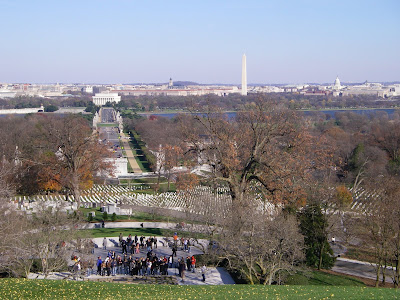Fred has been reading "The Lady of Arlington" about Mary Anna Randolph Custis Lee, Robert E. Lee's wife, so we decided to head over to Arlington National Cemetery to sightsee.


Mary was the daughter of George Washington Park Custis, who was adopted and raised by George Washington (his step-grandfather). GWP Custis designed and built Arlington House in honor of his adopted father. It became the home of Robert E. Lee upon his marriage to Mary Custis. At the beginning of the Civil War, the Federal government seized the Custis-Lee mansion (Arlington House) which overlooked the city and quartered troops there. The Federal government decided the mansion was the perfect place for a badly needed cemetery both practically (the Lees/Custises had a lot of land) and as an act of retribution against the Lees. After the war, the courts ruled that the land had to be returned to the Lee family, but it was no longer livable. By war's end, 16,000 graves surrounded the mansion. Robert E. Lee's son and heir, George Washington Custis Lee, sold the home back to the government for $150,000.

Above, the view of Washington, DC from the front yard of Arlington House. The people in the foreground below are visiting the grave of President John F. Kennedy. That's Memorial Bridge crossing the Potomac River into Washington, DC with the Lincoln Memorial, the Washington Monument and also the Capitol dome visible.

It's been years since I'd been to the Kennedy grave site at Arlington. When I was a kid, we visited soon after the burial. The last time I remember being there, it had a gravel walkway past it. Now it's very formal. That's the front portico of Arlington House atop the hill. Below, the visitors file by the grave site. Jacqueline Kennedy Onassis and the two children who died as infants are also buried there.

President Kennedy's brothers Robert F. Kennedy and Edward Kennedy are also buried near the President's grave site. Below, Edward (Teddy) Kennedy's grave.





































